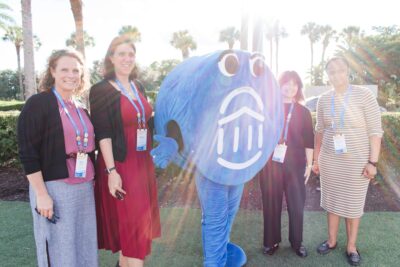5 ways higher ed peer networking helps strengthen student support
Your calendar is packed with color-coded meetings. Your desk is covered in sticky note to dos. Your inbox is filling faster than you can hit “mark as read.” Sound familiar? In my work with EAB’s partners across higher education, this is the reality I hear described again and again. You’re juggling more than ever before.
So, when an invite lands in your inbox for a peer networking event or a webinar, your first reaction might be, “Who has time for that?” But making time for peer connection might be the very thing that makes the rest of your work easier.
EAB’s Student Success Collaborative, the peer network for Navigate360 partners, is designed to bring these opportunities to busy student success leaders and practitioners. Over the past 12 years, we’ve seen the Collaborative help partners accelerate results—from faster onboarding to better student outcomes. Read on for five real examples of what peer networking has helped schools accomplish.
More on EAB’s Student Success Collaborative
The Student Success Collaborative connects over 850 institutions through a built-in peer network that helps partners solve problems faster and share what works. Whether through the online Community, virtual sessions, or the CONNECTED conference, the Collaborative makes it easy to connect with peers facing similar challenges. Partners post questions, exchange resources, and benchmark strategies in real time—transforming every interaction into a practical learning opportunity that strengthens student success efforts.
Why peer collaboration in higher ed drives better results
Higher ed is facing major challenges—enrollment declines, tighter budgets, shifting student needs, and policy uncertainty. But no one has to face them alone. The best strategies often come from peers who’ve already done the legwork to test them. Peer collaboration saves time, helps avoid common pitfalls, and exposes you to ideas you might not encounter otherwise, especially in a diverse community like the Student Success Collaborative where so many types of institutions are present.
We are really looking for examples of best practices that others have used to be successful. We are generating materials on our side, but don’t want to reinvent the wheel.
Current Navigate360 Partner
5 ways peer networking helps boost student outcomes
1. Find new ways to drive adoption
Peer networking helps institutions shortcut the trial-and-error process and borrow proven tactics for faster technology adoption.
In our user community, one partner asked:“What methods has your school used to encourage students to download the Navigate360 app and use it regularly?”
They received several actionable responses, including:
- Promote during orientation:“We made a QR code that takes them straight to the download link and included it on all our orientation materials—it’s helped a ton!”
- Embed in first-year experience courses:“We have them download the app as part of our freshman seminar. It’s one of the first assignments.”
- Use small incentives:“We’ve offered small giveaways like t-shirts or water bottles for students who show they downloaded the app.”
- Coach-assisted walkthroughs:“Success coaches walk through the app with students during their first advising appointment.”
2. Build stronger faculty engagement
The network becomes a sounding board to determine what works—and avoid missteps.
When one partner asked:“Has anyone had success with increasing the number of faculty submitting Progress Reports?”
They got several actionable responses, including:
- Timing matters:“We used to send requests during midterms but got better results shifting them earlier, around week 3 or 4.”
- Faculty champions:“We had a few faculty leaders talk it up at department meetings—that peer pressure helped!”
- Simplify the ask:“We narrowed our progress report to just 3 fields and saw a big jump in completion rates.”
Explore 4 Ways to Build Faculty Buy-In for Student Success Initiatives
3. Level up your usage of new features
Peer support helps users approach issues from different perspectives, leading to quicker adjustments and even better workflows.
One post asked:“How are you using automation to simplify Journey assignments?”
Here’s what others shared:
- Automate based on intake survey responses:“We assign students who express concerns about financial aid to a ‘Paying for Classes’ Journey. It walks them through scholarships, payment plans, and more. We also use survey responses to place students in an Undecided Major or Preparing for Graduation Journey.”
- Target unique populations with manual assignment:“Each semester, we manually assign students nearing graduation to a Journey that walks them through the graduation application process and helps them stay on track.”
- Streamline with custom attributes:“We use a custom attribute to control which Journey a student gets based on their academic program. For instance, only BA students needing language placement get that Journey.”
Learn More about Journey’s and the Benefit of Step-by-Step Student Support
4. Discover new campaign ideas
Peer exchanges turn the community into a living library of ready-to-adapt engagement strategies.
One partner asked:“We’re planning a campaign for students with 60+ credits who haven’t registered yet—what have others done?”
Here’s how peers responded:
- Target by academic standing and GPA:“We filtered by students with 60+ credits and a GPA below 2.5 to target high-priority students first.”
- Use motivating subject lines:“We used the subject line ‘You’re so close—don’t stop now!’ and it actually drove a great response.”
- Pair with multi-channel reminders:“We paired the campaign with a text message reminder sent two days later. I’m happy to send over our full message template if helpful!”
Check out this infographic with 65 Student Outreach Campaign Ideas
5. Benchmark with peer institutions
Peers provide instant benchmarking that can inform resourcing decisions and justify staffing needs to leadership.
In our user community, one partner asked:“How many staff do you have in your Advising Care Unit?”
They received responses like:
- Lean team structure:“We’re a small campus—just 3 advisors and our director. Our caseloads are around 200 students each.”
- Mid-sized advising model:“We have 9 staff in the unit: 7 full-time advisors and 2 part-time coaches.”
- Faculty-integrated model:“Our team is 5 advisors, but we also lean on faculty advisors for upperclassmen.”
These stories are just a small sample of the insights shared across the Collaborative every week. The ability to tap into real-time advice from other institutions doesn’t just save time—it helps drive better outcomes with less guesswork.
Make connection a priority
In the midst of what is undoubtedly another busy week, consider how you’re carving out time to learn from others beyond your campus.
Ask yourself:
- How am I regularly engaging with others in the student success space?
- What is one upcoming experience (EAB or otherwise) that I can join to learn from someone outside my team?
- In a world of virtual interactions, how can I connect live with others focused on similar priorities?
The most effective student success leaders recognize that connection isn’t a luxury—it’s a strategy. By making peer learning a priority, you expand your own capacity through the shared wisdom of a community dedicated to the same goals you are. Why tackle it alone when hundreds of colleagues are ready to share what they’ve learned?
Interested in becoming a Navigate360 partner and joining the Student Success Collaborative?
With over a decade of experience improving student success, we’re here to support every step of the student journey. Fill out the form to connect with an expert and see how EAB can streamline campus-wide success.

More Blogs

Four signs it’s time to break up with your student CRM

Three lessons from 1,200 student success leaders on higher ed’s future
